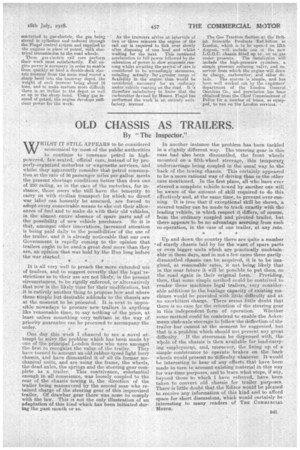COAL-GAS PROGRESS.
Page 16

Page 17

If you've noticed an error in this article please click here to report it so we can fix it.
A London County Council Lorry Using Compressed Gas.
In the .accompanying illustrations we show. a 24 h.p. .AIIdays two-ton lorry belonging to the London County Council, fitted to run on _compressed gas. The .equipment of this vehicle has been cartied out by MeSsrs. Fltigcl and Co., Ltd., 33a, Green Lanes, Newington Green, London, N. the •installation has proved to be quite -a success. The en gineer to the L.C.C. experimented for run) !time in running some of the. petrol lorries and petrol-electric tramcars be longing to the council on compressed gas, and quite a remarkable saving in cost is alnimed to hare been effected, although definite figures are not yet available, Pt.cept that it is asserted that the cost of cOrtilarmilla /las been found to be iosignificant, being actually only about one
penny per 250 cubic It. , of. gas. The Council's engineers-have fitted up: their own" compressors, and .so far as the vehic.les which are running on (impressed gas•stre concerned, they have entirely dispensed with the use of petrol.
As will be seen from the illustration of the complete lorry, the gas is stored in fairly large. cylinders, one carried at the rear below the chassis, and the otherin the front of the :body behind the driving cab. ,Each.cylinder is 'approximately -5 ft. long by 22 his. diameter, and gas is contained in them at a pressure of 150 lb. per sq. inch, From these cylinders the gas.passes.through the-Flugel -patent control valve carried on the dash, to the gas
• carburetter mounted on the intake manifold, both of which devices are sepa,rately Shown in the illnstrations. This insfallation"works quite satis%ctorily, enabling practically the last pound of pressure"in the container to flow freely to the engirie, and, as the petrol carburetter is not removed, the vehicle is able to be run en petrel, should by any mischance the gas supply fail. The principal reasons for the change have been the desire to save petrol and to • effect an economy in running costs.
Another development, of the L.C.C.'s Mobile power plant has been effected at the Balham tramwavg depot, which, like
others of the tramways depots, has no electric current laid down, so that:the electric tramcars have to be slinnted on and off the high road. For this jurpose three rail cars, each fitted with 45 Tilling-Stevett.s petrol-electric engines, have been employed at the Ban= depot, " and these three rail cars have now been
converted to gas-electric, the gas being stared in cylinders and reduced through the Flugel control system and supplied to the engines in place of petrol, with electrical transmisoon to the road wheels. These gas electric rail cars perform their work most satisfactorily_ Full engine power is necessary In order to enable them quickly to haul a double-deck electric tramcarfrom the main road round a sharp bend into the tramway depot, the weight of each tramcar being about 16 tons, and to make matters more difficult there is an incline to the depot as well as up to the sharp bend. Using gas instead of petrol, the engine develops sufficient power for the work. As the tramcars ar•rive at intervals of two or three minutes the engine of the rail car is required to tick over slowly after disposing of one load and whilst waiting for the next. This continual acceleration to full power followed by deceleration of power to slow economic run/ring whilst awaiting the arrival of cars is considered to be exceedingly strenuous, entailing actually he'greater range of flexibility in the engine than would he considered necessary for an ordinary motor vehicle running on the read. It is therefore satisfactory to know that the carburetter devised by Messrs. Flugel has performed the work in an entirely satisfactory wanner. The Gas Traction Section at the British Scientific Products Ead.ibition in London, which is to be open.'d on 12th August, will include one 01 the new L.O.C. chassis fitted up to an on gas under pressure. The installation will inchide the high-pressure cylinders, a, simple pressure seducing valve, and reservoir tom which the engine will draw its charge, carburetter, and other de tails. The system is simple, and has been well worked cut by the 4 ngirreers' 4partment of the London General Omnibus Co., and permission has been obtained from the .Chief Commissioner of police for a number of buses, so equipped, to ran on the Loudon services.






















